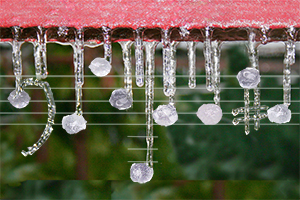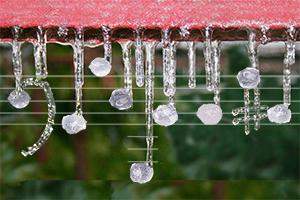
Saturday night’s concert celebrating Marin Alsop’s 20th summer as music director of the Cabrillo Festival of Contemporary Music provided sweet stuff: some delicious music for attendees, plus free cake for all afterward. Let’s defy critical conventions and review the program from the bottom up, in keeping with layers of the anniversary dessert.
The base slab at the end of the concert, one of several short works commissioned for this festival from favored composers, went back 50 years to the “cozy nightclubs” of an “adventurous and vibrant” Rat Pack Las Vegas. Adding quite a bit more big band to the cooler jazziness of Peggy Lee’s “Fever,” Michael Daugherty’s own Fever strode the Strip for five minutes in his usual unsubtle style and did not nearly impress patrons as much as his Gee’s Bend that preceded it.
Written for electric guitar and orchestra, Bend honored in four movements African-American quilters inhabiting a meander in the Alabama River 25 miles southwest of Selma. Like the residents’ art, Daugherty’s plan was to create a “patchwork of various crosscurrents.” But currents involving electrons were a detriment in the first movement, in which guitarist D.J. Sparr’s efforts at creating fuzz box and distortion in the style of Jimi Hendrix sounded instead unintentional and problematic. The second movement, “Grandmother’s Dream,” had better material. A blues solo for English horn added piquancy to a pensive melodic line in triple meter while the rest of the woodwind section gradually joined in, to fine effect. But the guitar seemed unnecessary — even wrong for the legato tune more suited to an electric or acoustic violin. More successful were the idiomatic and entertaining last two movements, “Washboard” and “Chicken Pickin’.”
The first half of the concert finished with the delectable Laconika suite, by Grawemeyer Award–winner George Tsontakis. This layer in the cake was a multifaceted feast in itself, with a very high quality calorie-per-minute ratio. One engaging sound after another was achieved more by taking timbres out of the orchestral mix than by putting them in. Furthermore, the resulting sound delicacies (such as the striking of a flimsy aluminum thunder sheet, a quasi-quotation from the Mozart Requiem, an up-and-down waggle of a European police siren), after whetting the appetite, were judiciously repeated. Who likes a cream cake with just one piece of strawberry in it? More composers should study baking with Tsontakis.
George Tsontakis’ Lakonika was a multifaceted feast in itself.
“Pop-sized,” “delicate,” “brief,” and “pithy” were the adjectives used by the composer in introducing the music, though “laconic” is not the only word behind the title. Tsontakis wrote the piece for LACO, the Los Angeles Chamber Orchestra. Showing again that he has few peers for compositional craftsmanship, Tsontakis cohered the four movements, “Alarming,” “Lacomotion,” “Mercurial,” and “Twilight,” with similar gestures and a continuous transparency of tone. I hope this terrific piece will be taken up by other orchestras in the Bay Area soon.
A Brick by Any Other Name
Before Laconika was Entangled Tales by Dutch composer Robin de Raaff. Thickica would have been a better title: This layer of pound cake without baking powder served only to make Tsontakis’ suite sound all the more masterful. If “heavy,” “muddled,” and “needlessly kitchensinky” don’t describe enough what the music was about, here’s what the program notes reveal:
Instruments are grouped together for complex collections of musical gestures, which are themselves combined to form what might be thought of as multilayered ‘supermotifs,’ as opposed to a simpler melodic or harmonic theme-group. ... In the largest sense, the experience is ebb and flow of musical density and intensity.
Preceding Raaf's pound layer was the literal icing on the program cake, Zosha Di Castri’s Alba. It is truly fortunate that composer John Adams didn’t have time to fulfill a proposed commission from the festival. Instead of just saying no, he took the gracious initiative in strongly recommending that the commission go to the young Di Castri instead. Her eight-minute contribution already shows a great flair for orchestration and tone painting, describing perfectly her plan for the music.
I wanted this piece to explore an alternative atmosphere of the coming of day. I tried to capture the startling emptiness one feels stepping out into a cold morning, the air clutching you by the throat it, it is so crisp. Yet there is a majestic beauty in this stark quilted silence and stunning flatness.
Bravo to both Di Castri and Alsop for this new blood: Di Castri’s ostensibly cold music warmed my heart and made me anxious to hear how her career develops as it goes from the top of a cake toward the top of her field.

